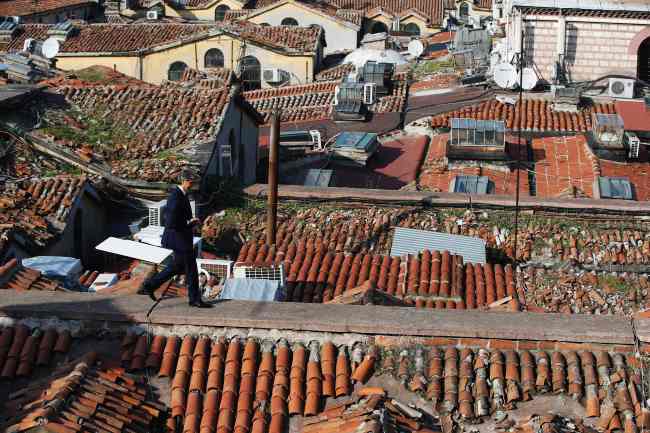ISTANBUL (AFP) – Over 500 years old, surviving fire and earthquakes, it welcomes up to 400,000 people a day and takes pride in being the world’s most visited destination — more popular than the Eiffel Tower.
So it’s hardly surprising that Istanbul’s venerable Grand Bazaar, built in the mid-15th century, has suffered some wear and tear over the years.
The labyrinthine bazaar is now about to undergo a much needed renovation that will last a decade and cost tens of millions of dollars.
But the revamp is not without controversy, especially among traditionalists who fear the spirit of the historic market will be lost.
“It’s the most visited destination in the world, so it’s very important for us,” said Mustafa Demir, the mayor of the Fatih district of Istanbul where the bazaar is located.
 |
| Mustafa Demir, mayor of the Fatih district of Istanbul where the city‘s historic Grand Bazaar is located, walks on the roof of bazaar on Feb. 1 in Istanbul. (AFP-Yonhap) |
“It’s a very long project which is going to need a decade,” he said. The cost is estimated at $33.5 million (30 million euros) which will be largely financed by the Turkish authorities.
The Grand Bazaar ranked as the top destination anywhere in the world with over 90 million visitors in 2014, according to a Travel Leisure listing.
Construction of the bazaar began around 1455 under the reign of Sultan Mehmet II, the “Conquerer” who had finally seized the city then known as Constantinople from the Byzantines in 1453.
With the city in need of a trade center for goods coming in from all over the nascent Ottoman Empire, the Grand Bazaar expanded rapidly.
By the 17th century it had taken on its current form, a covered market (giving the bazaar its Turkish name Kapalicarsi), which now has thousands of shops and dozens of streets.
It has become one of Istanbul’s most iconic sites, outstripping even the Hagia Sophia in terms of visitor numbers, and featured in a memorable sequence in the 2011 James Bond film “Skyfall.”
Visitors flock there to pick up souvenir trinkets or a carpet. Bargaining with the multilingual, friendly but famously hard-nosed shop-holders is all part of the experience.
Locals also come in droves to pick more prosaic goods like clothes, furniture or shoes, or possibly jewellery for a special occasion.
– ’Change is needed’ -
With the building’s foundations showing their age, the absolute priority is to give the bazaar back its structural stability, the restoration‘s architects say.
“The Grand Bazaar is built on a hill whose soil is permeated by water,” said Okan Erhan Olfaz, the engineer in charge of the works.
“The soil cannot sustain the building which is slipping down the slope towards the Golden Horn.”
One by one, trenches will be dug in the alleyways of the market. Engineers will build concrete tunnels through them to allow water, rain and discharges to pass and also to carry the electrical wiring which still hangs above from the bazaar’s walls.
“These galleries will solidify the edifice underground and stabilize the building’s columns,” said Olfaz.
Meeting under the framework of their union, the owners of the more than 3,000 shops in the bazaar agreed to also contribute for the renovation, convinced that it was necessary.
“It’s too cold here in the winter and in summer it’s too hot. And as soon as it rains there are leaks,” said a vendor, Kenan, who sells leather.
“There are lots of problems, I expect that will change soon.”
– ’Not a shopping centre’ -
But there are still dissenting voices, especially from among the small-scale traders who fear their rents could skyrocket.
“That depends on our landlords but we are expecting an unpleasant surprise,” said Mahmut, a clothes seller, in front of a pile of T-shirts.
“If that is the case we will be obliged to leave, We won’t be able to manage.”
With the government undertaking massive construction projects across the country that risk trampling on heritage, others fear atmosphere will be sacrificed to modernity.
The project also foresees the construction of two hotels in caravanserais — Ottoman-era guesthouses that were aimed at travelling merchants — on the edge of the bazaar.
“In Turkey, urban development takes place excluding the people,” said Cemal Gokce, president of Istanbul’s civil engineers chamber.
“I do not think that the project is aimed at reinforcing the historical and cultural identity of this edifice. With its long history, it’s wrong to make the Grand Bazaar simply a shopping center.”
But Demir, a close ally of President Recep Tayyip Erdogan, insisted that there was no alternative to the renovation.
“We are in the 21st century, there is no question of freezing the Grand Bazaar in its past,” said Demir. “We need to keep traditions going while responding to the needs of people today.”

